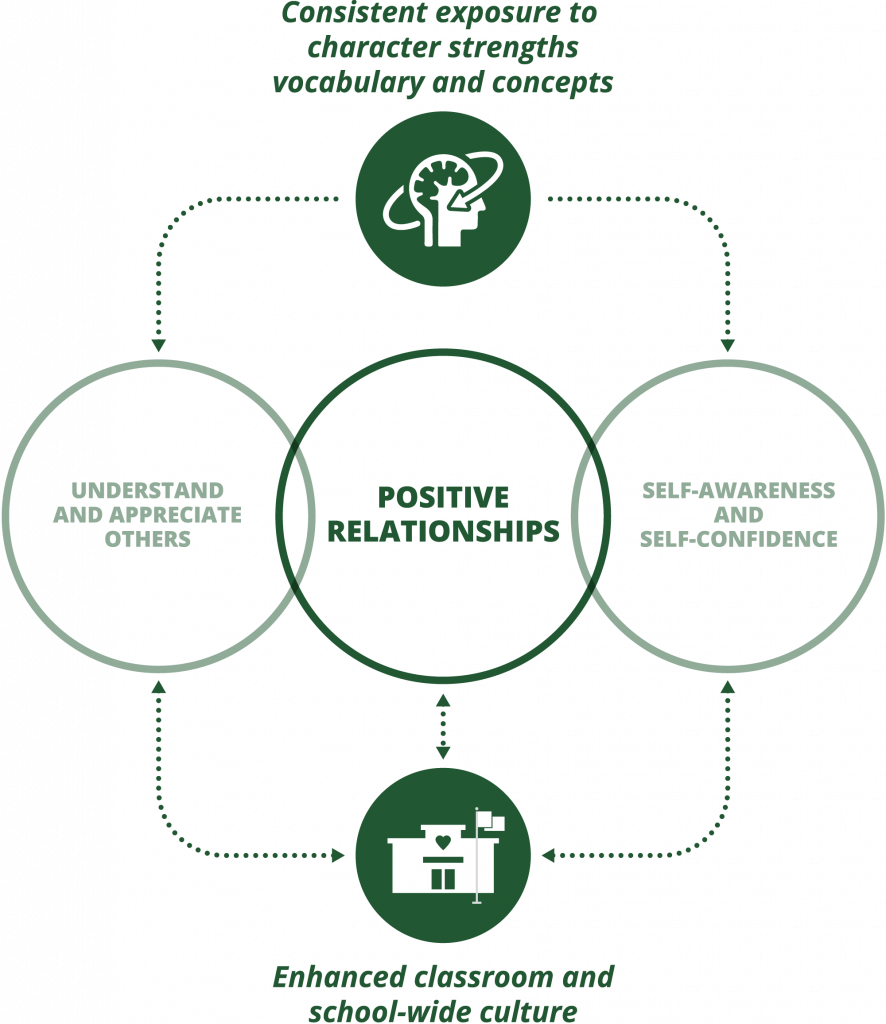Our Impact, I = EN
The Positivity Project is a nationwide movement. We base our impact on a simple equation: I=EN or Impact = Effectiveness (in each Partner School) x Number (of Partner Schools).
Effectiveness
Supported by Strong Empirical Evidence
The Positivity Project, which is grounded in positive psychology’s research on character and relationships, meets the criteria for a Tier 2 evidence-based intervention under ESSA.
A paper published in the International Journal of Education about P2 Partner Schools at the elementary and middle school level show that students reported significantly greater feelings of having quality relationships with others. When asked to name their favorite part of P2, the most frequent response from students was, “It makes me feel understood.” This is important because research shows that a student’s sense of relatedness is vital to academic motivation and social development. Read the summary here. Read the full paper here.
A paper published in the International Journal of Emerging Trends in Social Sciences highlights P2’s impact in elementary, middle, and high schools. As one educator explained, “I can honestly say I have never felt so good about a character education program in my teaching career. I can actually see this program working every day. Each week that we touch on new strengths, we are all reminded of our potential to be better human beings. We have truly seen a transformation in our program since we began using The Positivity Project…We have watched kids transform again and again, from disrespectful to respectful, from challenging to cooperative, and from ungrateful to grateful, just by modeling appropriate behavior, sharing learning experiences, and using character strengths to build relationships.”
Educator Feedback
In addition to measuring P2’s impact through academic research, we regularly solicit feedback from our Partner School educators to continuously improve our resources and student outcomes. To see what Partner School educators think about The Positivity Project, please click the button below.
Percent of Partner School educators believe P2 helps them better understand their students.
Percent of Partner School educators believe P2 helps students learn about themselves.
Percent of Partner School educators would recommend P2 to other schools.
P2 Stories
Watch the videos below to see what P2 looks like in action. Or, check out our Partner School Stories to read about P2’s impact. As one 8th grade student explained, “Perseverance and Perspective have been major strengths that helped me handle social and educational challenges. Being reminded that things will pass and that I have the ability to grow and learn from them have been incredibly helpful.”
Number
We are committed to growing fast because we believe The Positivity Project has an important role to serve in our country. Creating citizens and leaders who will enhance our communities and country cannot be confined to one demographic. We are growing through organic word-of-mouth, and partnering with schools in urban, suburban, and rural communities, in public, private, and charter schools. From 1 Partner School in 2015 to over 800 Partner Schools in 2022, The Positivity Project is just getting started.

Where We Were

Where We Are

Where We’re Going
Why P2 Works
The Positivity Project’s emphasis on consistency is grounded in research from child psychology and neuroscience. And, our focus on character and relationships is grounded in the research of Dr. Chris Peterson. As the adage goes, “Neurons that fire together, wire together.” Learn more about our model here.
Our Model

Why Focus on Character Strengths at School?
Dr. Peterson explained that focusing on character strengths “would not only make young people happier, healthier, and more socially connected but also help them do better at school and to be more productive at their eventual work. Attention to young people’s character is not a luxury for our society but a necessity, and it requires no tradeoff with traditional academic goals.”
P2 Partner Schools consistently teach students about the character strengths that everyone possesses. This helps students become more self-aware and empathetic – leading to more positive relationships and a more positive school culture. This positive culture allows teachers to focus on teaching and students to focus on learning.
Why ALL 24 Character Strengths?
Sometimes people ask, “Why are you focused on ALL 24 character strengths? Why not just 6 or 10?” That’s a good question. The answer is that The Positivity Project’s model is grounded in the research of positive psychology’s character strengths. And that research clearly shows that “All 24 Matter.” As Dr. Ryan Niemac explains, “the importance of any given strength will vary by the situation or the intended consequence…[and] how they matter will vary by person and situation.”
So, if we want students to be equipped to consciously leverage the strengths they’ll need throughout their lives in a variety of situations, they must learn about all 24. This also makes P2 more applicable to every student. Some students may identify more with optimism and enthusiasm, while others may identify more with humility and prudence. Every single one of the character strengths is important — and the 24 character strengths provide a broad common vocabulary for classrooms, schools, and districts.
As Dr. Peterson summarizes, understanding all 24 “provides a useful vocabulary for people to talk about character strengths in an appropriately nuanced way. Simply saying that someone has good character (or not) does not lead to anywhere useful. In contrast, using the strengths concepts…people can describe the profile of strengths that characterize each individual.”
Why does P2 emphasize consistency?
Our model is holistic and rooted in consistency; it incorporates and impacts students, educators, and families through regular interaction with character strengths vocabulary and concepts. Our emphasis on consistency is grounded in research from child psychology and neuroscience.
To most effectively learn a new word, concept, or skill, students should be exposed to a combination of active learning (pair-sharing, building, discussing, drawing), passive learning (listening, watching, generalizing), and settling time (walking, reflecting, sleeping, eating). It’s important to spread out the learning to maximize consolidation – the physical process of turning electrical and chemical input into a memory (Jensen, Teaching with the Brain in Mind, Revised 2nd Edition, 39-43).
This consistency is why 8th grade students at J.M. McKenney Middle School say things like, “Perseverance and Perspective have been major strengths that helped me handle social and educational challenges. Being reminded that things will pass and that I have the ability to grow and learn from them have been incredibly helpful.”
Dr. Chris Peterson explained, “Theorists as far back as Aristotle argued that virtue is the product of habitual action. One-shot positive psychology interventions can probably jump-start the process, but only sustained practice will make changes permanent.”
Are These Words “Over Students’ Heads”?
Another question people ask is, “Aren’t some of these character strengths over students’ heads?” Simply stated, they’re not. P2’s grade-level differentiated resources provide scaffolded definitions, examples, and activities to help students understand and apply character strengths in their lives.
As one English Language Learning teacher explained, “Ms. Saleh asked her students, ‘What is another character strength this person is showing?’ and the responses were incredibly intuitive! Kindergarten students were raising their hands and using the words “Integrity,” “Perseverance,” and “Gratitude”…Ms. Saleh’s students use these words with such tenacity and it seems so natural to them…If these character strengths are in their vernacular as kindergartners… imagine how their knowledge will deepen and experiences building positive relationships will flourish.”
As another teacher highlights, her students were able to use their command of character strengths to teach a local baseball coach about the concept of prudence in athletics.


